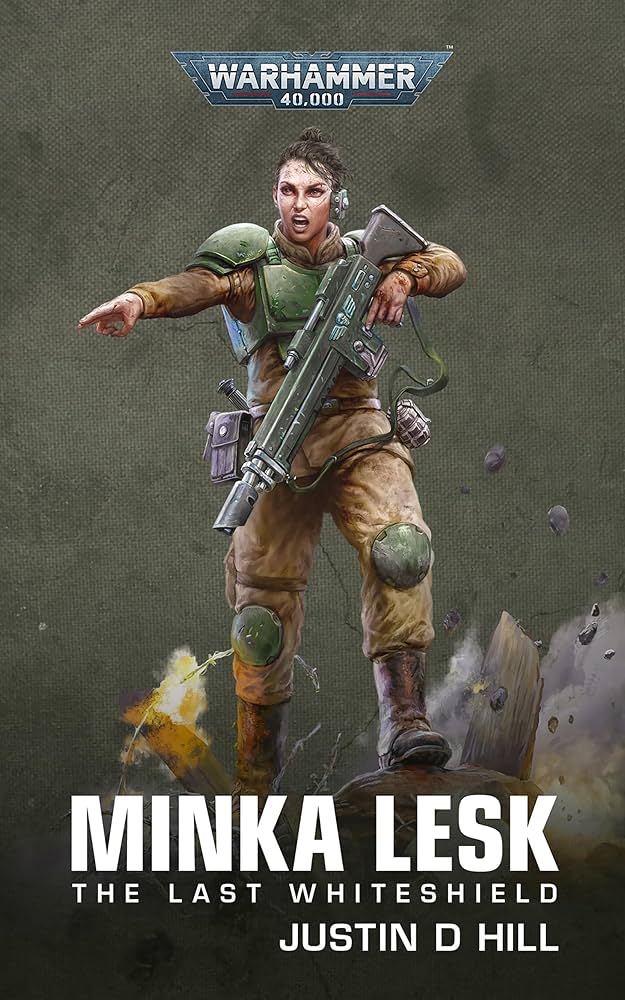Minka Lesk is everywhere at the moment. On the page, with a fifth novel featuring the Cadian hitting the shelves soon, a slightly controversial single miniature, a whole set of fantastic sculpts of a command squad and video game appearances aplenty. Why?
To be honest, I was pretty mystified. I’d read Minka’s first and second appearance in the pages of the Black Library some point pre-pandemic, but missed out on subsequent novels. It seems like a lot of coverage for an Imperial Guard hero – as many miniatures as Gaunt, Eisenhorn or even Horus, have received. I thought I’d pick up the omnibus collection Minka Lesk: The Last Whiteshield and work out why Justin D Hill’s creation is receiving a level of miniature support whole ranges could only dream of.
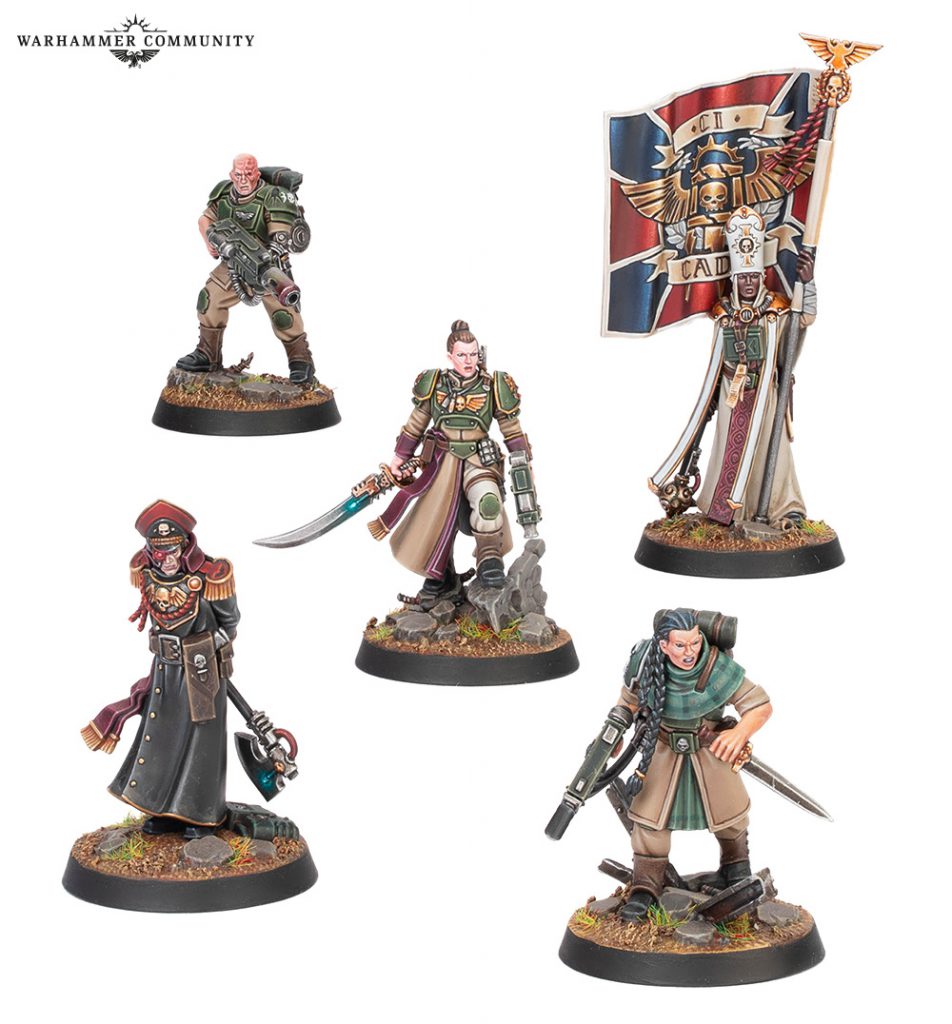
If you caught the Minka Lesk stories as they came out, you’ll have read them as separate books – Cadia Stands, Cadian Honour and Traitor Rock – but now there’s a single stand out option, picking up Minka Lesk: The Last Whiteshield, a massive tome collecting the three novels and two short stories. It’s certainly bloody excellent value for money in terms of words-per-penny, but are they any good, and does Minka’s story warrant a series of celebration miniatures?
Cadia Stands
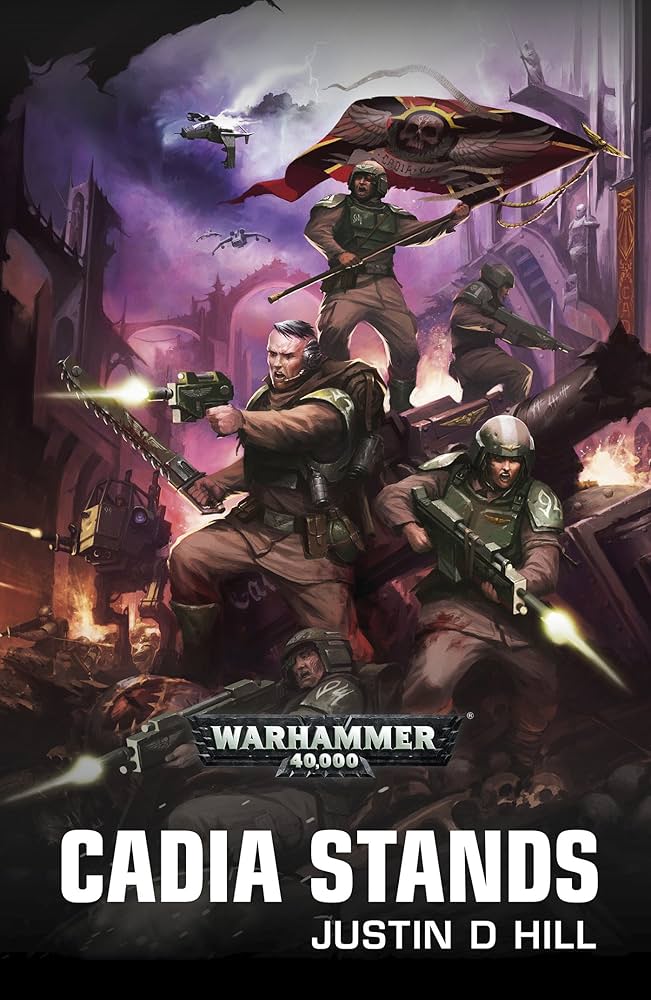
Cadia Stands is a bit of a weird one. Published in 2019, not a huge amount of time after the cataclysmic events of the 13th Black Crusade were outlined in the Gathering Storm series, it was one of the first novels about the fall of the Cadian gate and signalled the beginning of a loose thematic series that has run out and beyond Justin Hill’s works.
I had read this one, but had, if I’m honest, completely forgotten about it. I’d mixed it up with Robert Rath’s Fall of Cadia – a very different book. Rath’s Fall of Cadia is a kind of Novelisation of the Movie – the Gathering Storm books rendered down into a big, fat, novel that reads like a tabletop game and is intensely focused on replacing the out of print Gathering Storm. Rath’s Cadia is full of the big characters and their various well-known shenanigans, very big picture. Cadia Stands is a lot more personal, dialled in and attempts to tell a version of the story that you couldn’t originally find in campaign books. In many ways it’s what I would describe as a classic Black Library book; it’s readable, there’s lots of combat and it’s structured to provide a variety of viewpoint characters telling a big story in personal chunks. It’s a straightforward book and falls squarely into the “first book for the Black Library” Imperial Guard story set.
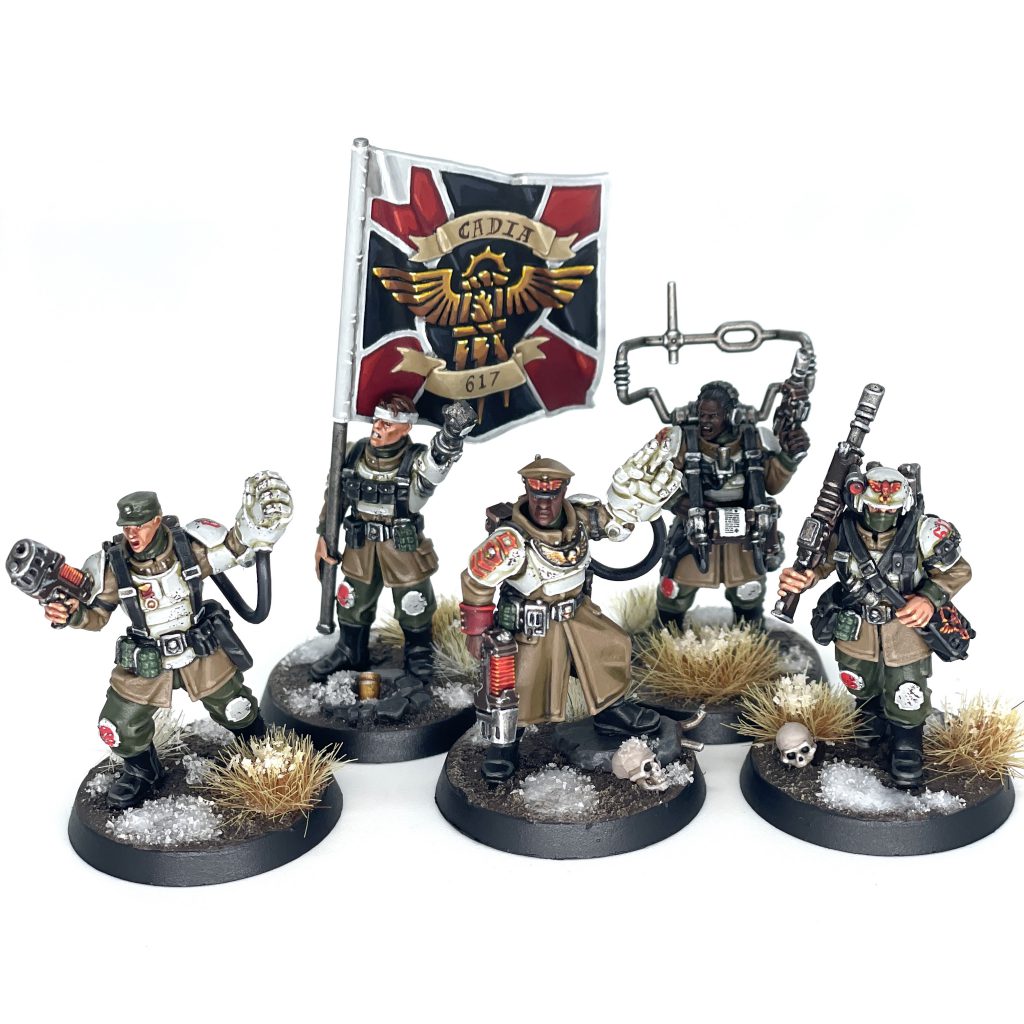
Out and beyond this though, there’s not a huge amount to recommend. Hill has the honour of writing a book with a surprisingly large amount of influence on subsequent developments of Imperial Guard lore – how much of this was at the behest of editors and how much was Justin Hill I don’t know – but the long tail of “Cadians wondering what the hell happens next” starts here, and that’s an achievement and a half.
As a standalone novel though, it’s a bit rough. Description is occasionally pretty clunky – there was a point when several characters in a row “drew themselves up to their full six feet”, for example – while combat lacks the zip and zing present in other Black Library offerings and dialogue sometimes falls very flat. It’s not a hard read, by any means, and nothing in it is a dealbreaker, but it’s a very weird one; Justin D. Hill is Justin Hill, and his non-40k stuff doesn’t read like this at all. It feels a bit rushed, as if there needed to be a novel in that time at that place covering the fall, and damned be to anything else. The structure of the book doesn’t help, and I think a different editing pass would have chopped and changed the order we encounter some of the POV characters. There’s a few too many, some aren’t that well developed and one in particular is just pretty rubbish. The switches mean that when you want this sweep of noble tragedy, instead there’s a strange dislocation that breaks up the rhythm, not helped by the Creed Ex Machina that everyone writing about the Fall of Cadia is forced to include.
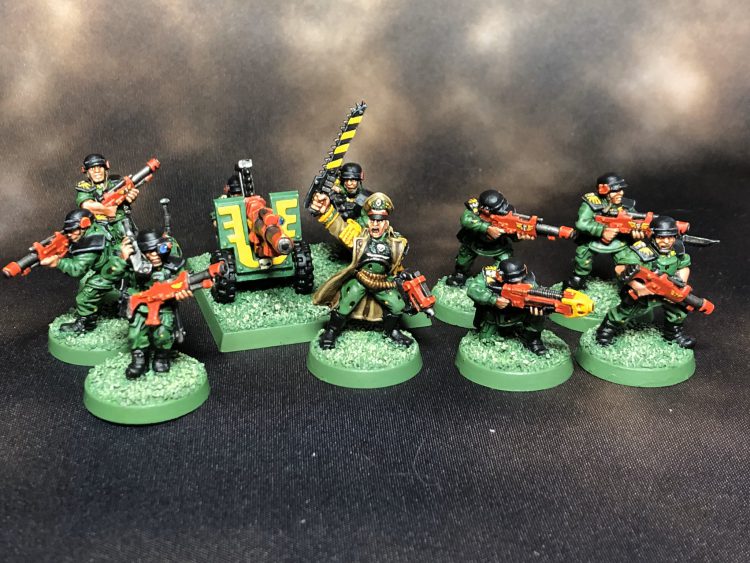
Where it’s good is in the large scale description that reads like non-fiction; all massed Sentinels, flanking maneuvers and a scrabble for support assets. Those were the bits I was chasing after, hoping that the focus would move back out – when we zoom in to individuals the book struggles. Except for Minka, and I suppose that’s why we’re here. The Minka sections, of a terrified whiteshield fighting for her life in a hopeless retreat, are really good. There’s fire, faith, fury – and fun – here, lovely/horrifying description, good old fashioned bolter porn and character work. Cadia from the eyes of a cadet is a good story, and you can tell that there’s a drive to write in these sections that’s absent when the story moves out to armoured commanders or the Space Wolves. Those sections don’t quite make up for the rest, but you can see the seed of an idea worth developing.
Short Stories
There’s a clear setup for a sequel, or set of sequels, at the end of Cadia Stands, playing with some big themes and big ideas in the 40k universe, but what’s fascinating to me is that we don’t get that at all. Instead, from the germ of the question “what’s this Cadet going to do in New Cadia”, we got a whole series about one Cadian in particular. It’s in the Place of Pain and Healing and the Battle for Markgraaf Hive that the focus narrows in on Minka. Filling out Minka-as-character is a good shout, taking the most interesting perspective in the novel and giving her a bit more heft and body as she struggles to recuperate during the long slab of the novel she’s absent from and is then thrown into hell.

Both stories are flat out better written than the preceding book too – description is more evocative, characters are fuller (for all that there’s very few in the limits of a couple of pages), the story is just a bit more interesting. You could incorporate Place of Pain and Healing into Cadia Stands and improve it for a subsequent reissue, and it feels very much like it’s written with that in mind, or perhaps it’s Justin Hill relaxing into writing Cadians. Everything is just that little bit better, the beginning of an upward trajectory for the series. By the end of Markgraaf Hive I was invested in Minka, interested in where she was off to and looking forward to more.
Cadian Honour
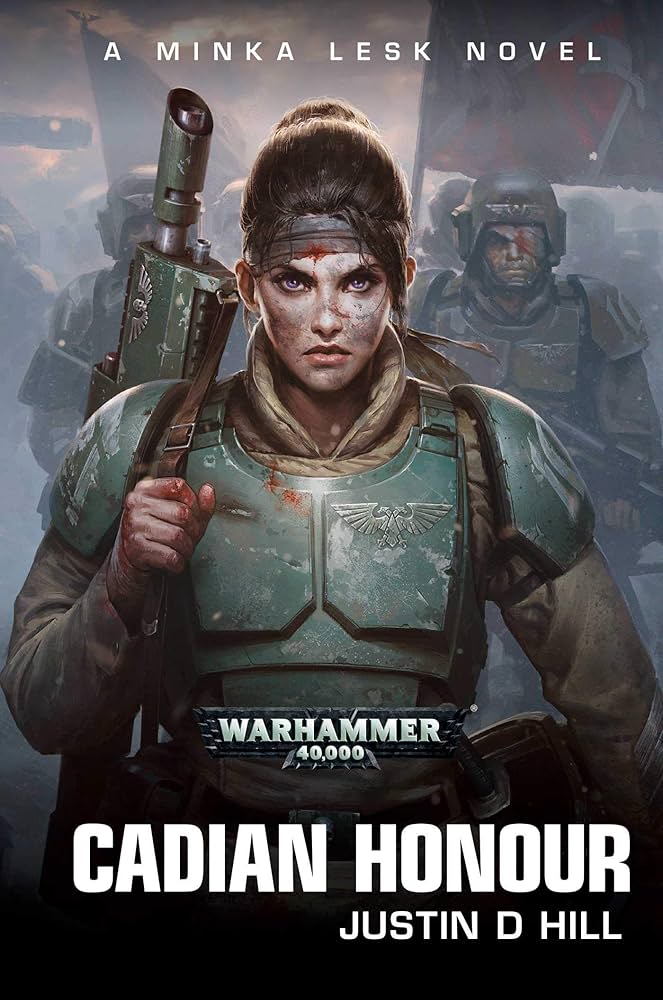
Then Cadian Honour happened.
Okay, that’s a little blunt, but I found this book a real slog to get through. We’re taken to the world of Potence, given the same two major viewpoint characters (Minka and General Bendikt), a whole massive array of others, and then immersed in what feels like it should build to a really satisfying shooty shooty conclusion of heresy and madness. So it builds… and it builds… and then it keeps building… and then more building… and then it ends. There’s a clear intent here of creating a spider’s web of loyalties, motivations, heresy and intrigue, but with the sheer amount of world/plot building that goes on here, we’re left with major threads that are too clear and simple to work out. The (more or less) ending twist is foreseeable about two chapters in; the supporting cast seem like they might switch up roles, but don’t – it’s a head-feint of complexity. At this point, a thought was slowly dawning on me, but it would take another full book for me to work out why Cadian Honour was the way it was.
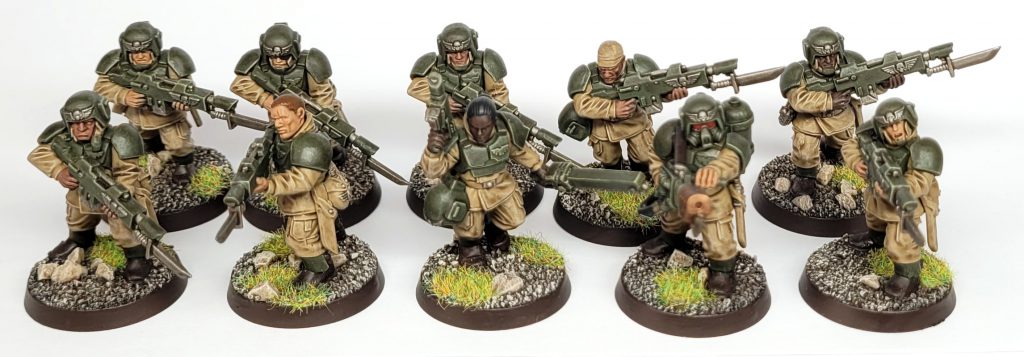
While there’s some serious clunk here, there’s also a lot of good, and exploring what it means to be Cadian in a galaxy without Cadia is well worth the effort. There’s some fun Imperial weirdoes, but it never quite feels to be in the same galaxy as everything else – the edges of the Imperium are softer, the nobles a little less weird, the soldiers a bit more modern.
Minka remains the highlight, navigating increased responsibility, her unerring ability to be exactly where she needs to be at any one particular time, and toying with the limits of plot armour in a satisfying way. When we’re focused in on her, again, it’s a nice digestible read – simple prose, and simple plotting. Unfortunately, from Minka we often move to Bendikt, a man on his own personal journey into alcoholism while defending Cadian Honour (hey! That’s the name of the book!) to the hilt. Bendikt is definitely a complex character, but for me the main complexity is, “How did a man so utterly stupid end up a General?” He’s a man who seems absolutely incapable of noticing subtext – and this is where the otherwise delightfully accessible prose and plotting of the book becomes a hindrance. The reader can pick up on subtext and hints, when Bendikt seems oblivious to them to a level that becomes physically painful. He will remain like this for every other book he appears in.
Traitor Rock
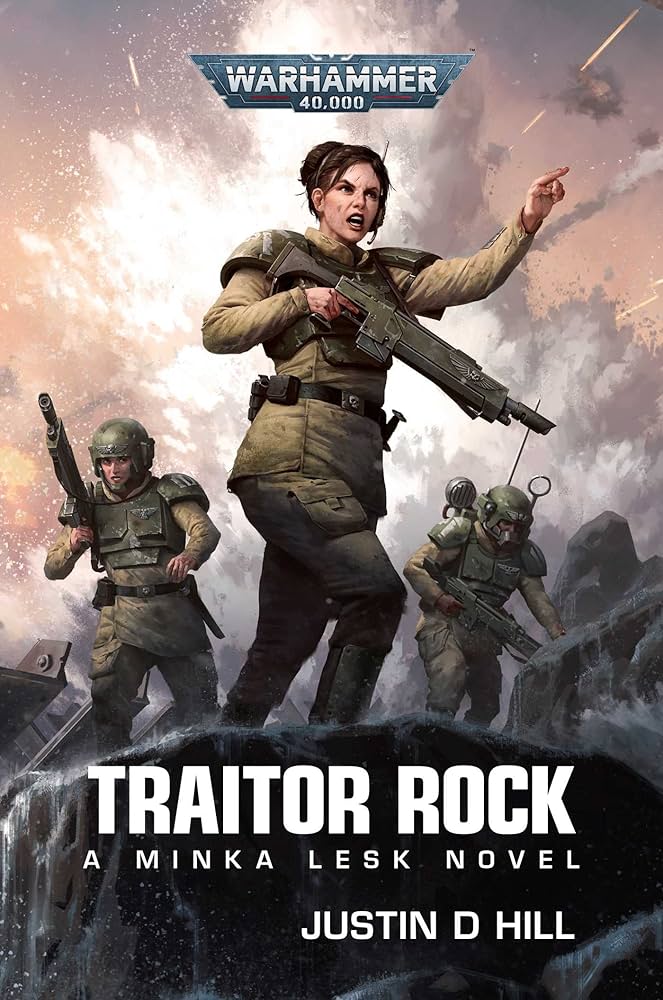
Oh my god Bendikt, you bloody idiot.
While Cadian Honour was a difficult read, I quite enjoyed Traitor Rock. There’s a definite pattern with longer-running Guard series (I’m sorry, editor, but I can never bring myself to call them Astra Militarum; it’s the Napoleonic grog in me), where after an intro book and a big war book (see First and Only and Necropolis), you get to pick up the regiment and put them in a historical inspired combat and see how they run. I am an absolute goddamn sucker for this. If you put your made-up Guard characters onto Omaha Beach, Jarhead, or the Guns of Navarone, I am going to eat that shit up like a hog. Do all three in one book – as Hill does here – and it will instantly become my favourite book in the series.
Traitor Rock has the Cadians take on a notable traitor fortress that we’re told (often) has repeatedly withstood all that the Imperium can throw at it. Great premise that leads to beach landings, insane wire-bound assaults, cannon fodder nonsense and volcanic eruptions. It turns out pretty easy for the Cadians to take it, which is a good concept – the real soldiers are here, watch us do this properly, peasants! – but in practice it just makes everyone look like idiots because the resolution is so very simple. Far from an impregnable fortress, the Traitor’s eponymous Rock is an aphid (that comparison made sense in my head) that comes with ready, obvious and exploitable weak points. There’s too much tension drawing build up, as in Cadian Honour, for the resolution to be simple. But it is.
While the story is Minka’s – and again, she does good here, Hill writing her with a simple but clear and effective set of motivations, even twisting the emotional knife a fair few times to good effect – the agony is in Bendikt. I wish there was another version of this book with his role entirely excised because his actions and writing here make him into a complete dullard. It’s not a “hate a hateable character” thing, because it’s never quite certain if you’re supposed to think of him as General Melchett, a drunk, or a hero. The ambiguity doesn’t feel like, “oh the nature of man is fickle,” but instead unfocused. If you told me the intention was one way or the other, I’d believe it – but I don’t believe the intention is to have him as a military genius who is also a bloody fool.
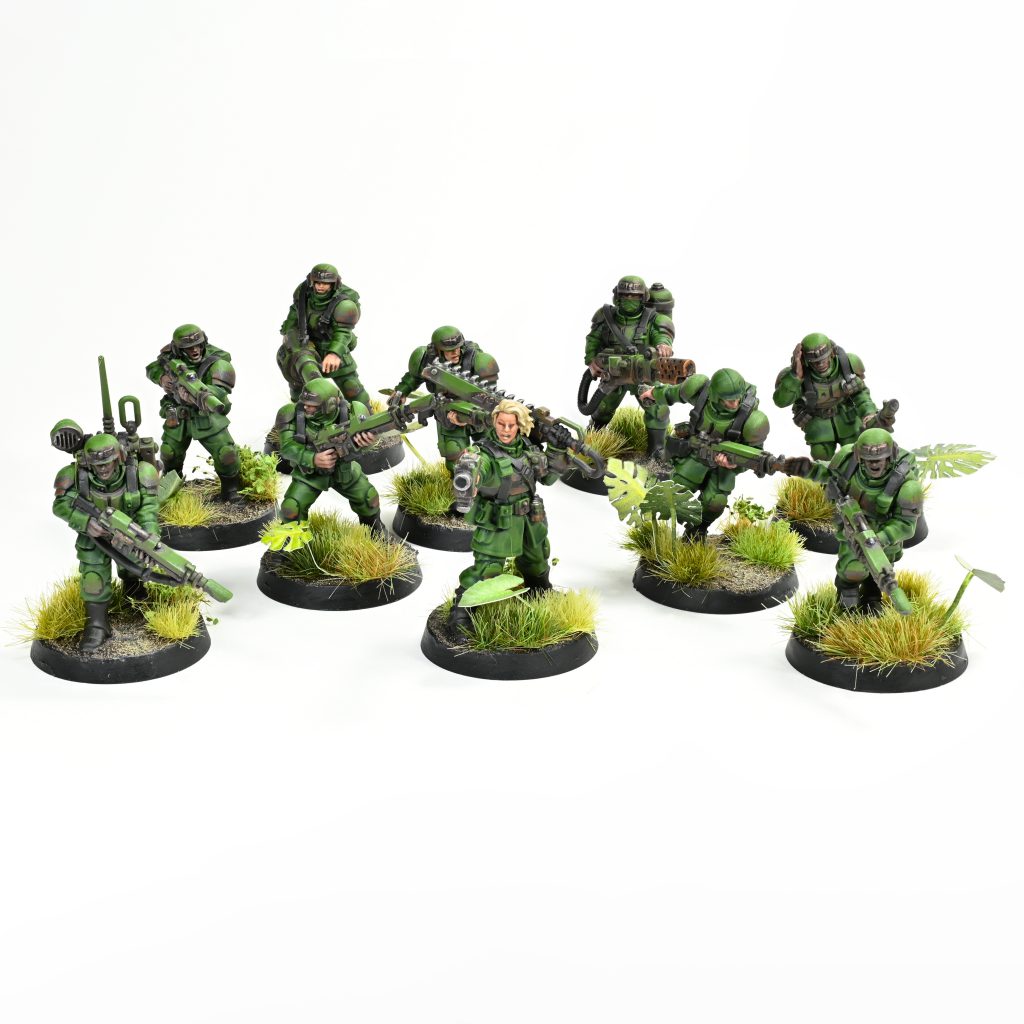
For all that Traitor Rock has my favourite things in it, several Normandy beach landings in a sci-fi setting, military hospitals, inter-regimental rivalry, big pipes etc etc, there was a point in it where I realised why Minka keeps getting miniatures and it wasn’t that these are excellent books (they’re okay). About half way through, there was a little bit of clunky dialogue and writing, and a vicious assault that had a strangely bloodless, sanitised end that seemed all a bit too easy. That sounds bad, but reading it was a lightbulb moment and I got it.
Accessibility
The collected Last Whiteshield presents three relatively simple books with straightforward plot and characterisation that makes them an accessible read to an extent that the Black Library often lacks. The feel written for a different, and possibly younger audience. Violence is present, as you’d expect, but it’s all cauterised wounds or impacts – you have to wait until the end of Shadow of the Eighth (not in this collection) to get any “40k style” madness and horror expressed through ultra-gory death and mayhem. Enemies are simple – Traitor’s Rock has some heretics who are just, well, they’re just heretics – and their motivations stand apart from the kind of depraved lunacy you expect from the forces of Chaos. The enemies have clear weak points and they can be defeated by bravery and cunning, a bit like reading the Victor Book for Boys but without the racism. Even the Imperium is a kinder, gentler place. Heroes are rational, faith in the Emperor is secure (and just), everyone is rational. There is little of the “reality” explored elsewhere, that the Imperium is a Horror Machine built to perpetuate itself at any cost.
When there are chunks of more traditional ultraviolence they’re fleeting and obscured – the traitor marine appearing in a short story feels like something out of ADB’s work, but is there for less than a paragraph, with no loving descriptions of flayed skin and unimaginable horror. That’s a clever move, in my opinion. There’s a whole lot of Black Library fiction that reads like grindhouse splatter horror – and perhaps it should, in the grim darkness of the far future and all that – but there are levels, particularly when opening up 40k tie in fiction to younger audiences. Demons on Cadia in the fall are dark shapes, dogs, hounds, scary yes but they’re not turning people inside out from the arsehole up, with all the colourful description that comes with it. It feels 40k, but with just enough difference to make it a 12, not a 15.
Reading Whiteshield
It’s not just content that creates this accessibility. Word choice, sentence length, simile over metaphor and as little ambiguity as possible all make these a straightforward read. To test this out, I took a few excerpts from a couple of Black Library books and ran them through the Flesch reading ease test (because I know it better than other readability tests!). The Flesch test is pretty easy, examining length of sentences and length of words in a section of text. High Scores (the test runs 1 to 100) are easiest to read. A score of 100 should be readable by eleven year olds using their native language – around 20% of native English speaker adults in the UK will find this level of readability difficult.
That eleven-year-old level is an important one, because that’s more or less Games Workshop’s target audience for hooking us up into the world of Warhammer. Most Black Library books, however, run significantly lower scores that indicate a higher degree of difficulty. By the time you get to a score of 50 (and accept a bit of fudging), you’re looking at somewhere between 30-40% of adults in the UK who will struggle to engage with your work and most children under 16 – a significant part of the 40k readership, adult or no.
To test this out, I used 1,000 word passages from recent big releases, taking one from each Minka book and averaging them out – the reading ages below are a bit estimated:
| Novel | Flesch Ease Score | Reading Age |
| Minka Lesk (collected) | 86 | 11-12 |
| Warhammer Adventures – Shadow of the Necron | 75 | 12-13 |
| Avenging Son | 67 | 13-15 |
| The End and the Death | 57 | 16-18 |
I don’t think it’s any surprise that Abnett Unleashed is a more complex read, but the surprise for me is in Warhammer Adventures – the series deliberately written for children – scores lower than the first three Minka books.
An 86 is bloody difficult to write – I can’t do it at all. It’s a real achievement, translating a world that is often difficult for a significant minority of adults to understand, into novels that can be picked up, easily read and enjoyably understood by almost everyone GW are targeting. That isn’t something that we see often in the Black Library but is very much the aim of other tie-in fiction franchises. Onboarding through “lore” is a really critical part of the relentless media franchisation of our cultural world. Games Workshop are moving from big-but-niche and preparing to storm the big wide world through the Amazon partnership, and I’d be surprised if conversations around producing accessible onboarding ramps for wider audiences weren’t happening somewhere in Lenton. Traditionally, the Black Library is absolutely naff at onboarding, to be honest – the “best of the best” books are occasionally good introductions (Eisenhorn, for instance), but aren’t easy to read. The Horus Heresy, so often given as a place to start reading about 40k, is a godawful onboarding point, a meandering 60+ book series that throws up a variety of challenges to reading beyond those that a prequel series usually offers. Gaunt’s Ghosts, the other big legendary start point for people starting off on 40k fiction is similar – a harder read than segments of GW’s target audience (adult and child) are likely to be comfortable with.
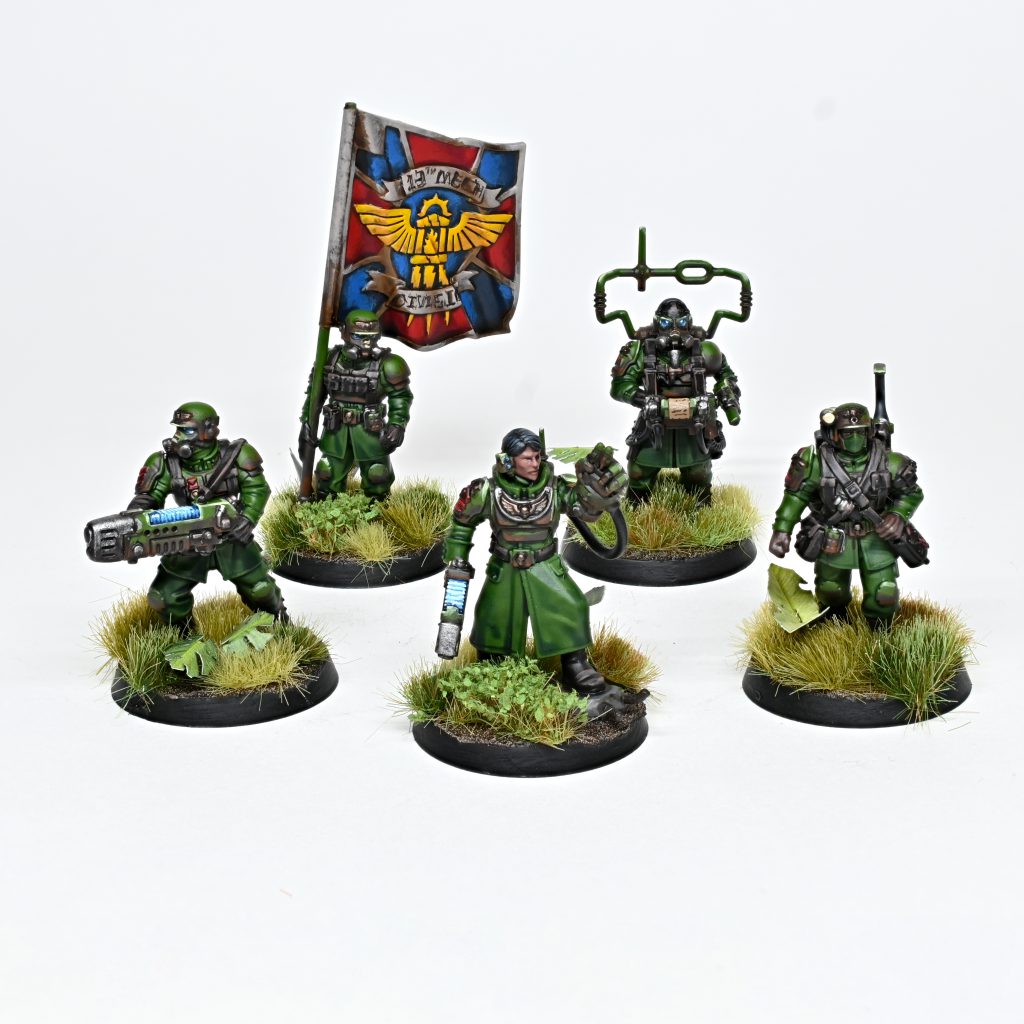
Everything about the Minka Lesk books, particularly those collected in The Last Whiteshield Omnibus, seems designed to provide that onboarding. We are taken through the “safe for work” and straightforward version of the Fall of Cadia. We are gradually introduced to the world of Warhammer, expanding out from the Guard slowly, introducing more and more world elements in each piece. The ongoing meta plot of the Cadians, the riven imperium and the great rift is introduced, but doesn’t carry over too much between each book. If you want an introduction to the universe of Warhammer 40k and the current plot threads the “lore” is exploring, you could start here and have a good, straightfoward introduction. You’re not being chucked in at the deep, bloody and weird end.
Minka herself is a simple protagonist – quiet, determined, always right – and Bendikt an understandably complex authority figure. Prose is as straightforwardly accessible as it could well possibly be in a universe filled with multi-syllable nonsense. Nothing here is providing challenge, forcing readers to piece the narrative together or even leaving emotions unsaid (or unthought). There’s no fucking, and mostly socially acceptable violence. Minka’s gender is explored slightly, in a way that would be palatable to 11-12 year old readers (A question for wiser minds than mine – does anyone ever have a period in the far future?). For many readers, particularly for the younger element of GW’s potential readership, these are perfect novels to recommend.
Last of the Last
There’s an interesting and obvious thought here: not all novels about Warhammer are for every fan of Warhammer. There’s sometimes a perception that everything in our hobby needs to speak to every member of it – the outcry when a book is a certain way, or a model is made the way it is. We don’t think of general science fiction or, god forbid, fiction as being one size fits all, that every book ever written will be enjoyable, readable, even understandable, by everyone. The Black Library is now the size of an actual library, upwards of a thousand books, and some of them simply won’t be written for me – or possibly for you. That’s more than ok, it’s a sign of a healthy and growing literary franchise and I can’t wait to see more of where this could go.
I think the Last Whiteshield is for the younger members of our hobby community, and that’s great! A Warhammer 40k that is slightly less horrific, easier to access and less labyrinthine, while still being recognisably the grim dark future, is much needed – and a very difficult balance to strike. That makes them an excellent place to push out a growing franchise, to translate into miniatures and potentially allow new readers to make the jump over to models while giving established hobbyists another great set of command models for a popular army. This is 40k as Young Adult literature, and all power to it in opening up a new audience. While they’re not for me, these books are for someone else, and they’ll get a lot out of them.
Have any questions or feedback? Drop us a note in the comments below or email us at contact@goonhammer.com. Want articles like this linked in your inbox every Monday morning? Sign up for our newsletter. And don’t forget that you can support us on Patreon for backer rewards like early video content, Administratum access, an ad-free experience on our website and more.
